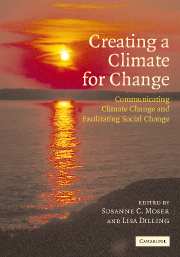Book contents
- Frontmatter
- Contents
- Preface
- Foreword
- List of contributors
- List of tables
- List of figures
- List of text boxes
- Introduction
- Part I Communicating climate change
- Part II Facilitating social change
- 15 Stuck in the slow lane of behavior change? A not-so-superhuman perspective on getting out of our cars
- 16 Consumption behavior and narratives about the good life
- 17 Educating for “intelligent environmental action” in an age of global warming
- 18 Education for global responsibility
- 19 Changing the world one household at a time: Portland's 30-day program to lose 5,000 pounds
- 20 Changing organizational ethics and practices toward climate and environment
- 21 Change in the marketplace: business leadership and communication
- 22 The market as messenger: sending the right signals
- 23 Making it easy: establishing energy efficiency and renewable energy as routine best practice
- 24 Forming networks, enabling leaders, financing action: the Cities for Climate Protection™ campaign
- 25 Ending the piecemeal approach: Santa Monica's comprehensive plan for sustainability
- 26 States leading the way on climate change action: the view from the Northeast
- 27 West Coast Governors' Global Warming Initiative: using regional partnerships to coordinate climate action
- 28 Building social movements
- 29 Climate litigation: shaping public policy and stimulating debate
- 30 The moral and political challenges of climate change
- Part III Creating a climate for change
- About the authors
- Index
- References
23 - Making it easy: establishing energy efficiency and renewable energy as routine best practice
Published online by Cambridge University Press: 20 August 2009
- Frontmatter
- Contents
- Preface
- Foreword
- List of contributors
- List of tables
- List of figures
- List of text boxes
- Introduction
- Part I Communicating climate change
- Part II Facilitating social change
- 15 Stuck in the slow lane of behavior change? A not-so-superhuman perspective on getting out of our cars
- 16 Consumption behavior and narratives about the good life
- 17 Educating for “intelligent environmental action” in an age of global warming
- 18 Education for global responsibility
- 19 Changing the world one household at a time: Portland's 30-day program to lose 5,000 pounds
- 20 Changing organizational ethics and practices toward climate and environment
- 21 Change in the marketplace: business leadership and communication
- 22 The market as messenger: sending the right signals
- 23 Making it easy: establishing energy efficiency and renewable energy as routine best practice
- 24 Forming networks, enabling leaders, financing action: the Cities for Climate Protection™ campaign
- 25 Ending the piecemeal approach: Santa Monica's comprehensive plan for sustainability
- 26 States leading the way on climate change action: the view from the Northeast
- 27 West Coast Governors' Global Warming Initiative: using regional partnerships to coordinate climate action
- 28 Building social movements
- 29 Climate litigation: shaping public policy and stimulating debate
- 30 The moral and political challenges of climate change
- Part III Creating a climate for change
- About the authors
- Index
- References
Summary
We all depend on energy to meet our basic needs and support our lifestyle. From cars to cell phones to microwave ovens, most products we use require energy. In the United States most of this energy comes from non-renewable and fossil fuel sources (Table 23.1). Interestingly, for more than 30 years, a majority of Americans has stated that they prefer energy-efficient products and renewable energy over other sources of energy (Farhar, 1994; Coburn and Farhar, 2004; Greene, 1998). And yet, products and services often do not reflect those preferences, while energy use continues to rise in the United States. For the most part, energy profligacy – rather than energy efficiency – has been routine in the United States. In the sections below, we discuss some of the reasons for Americans' high energy consumption and the disconnect between expressed wishes and consumption reality. We also show how seamlessly embedding energy efficiency and renewable energy into products and energy services is necessary if society wishes to reduce energy waste as well as greenhouse gas emissions. “Making it easy” for companies and households to use sustainable energy products and services is a critical element of a comprehensive strategy toward greater sustainability. “Making it easy” means investing the resources to make energy-saving and sustainable-energy choices routine through a variety of mechanisms, which we discuss below. If the use of efficiency and renewable energy is made routine, the time spent on potentially complex decisions can be lessened or avoided altogether.
- Type
- Chapter
- Information
- Creating a Climate for ChangeCommunicating Climate Change and Facilitating Social Change, pp. 359 - 382Publisher: Cambridge University PressPrint publication year: 2007



